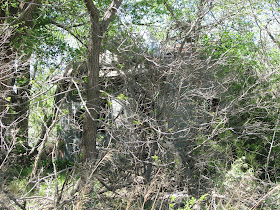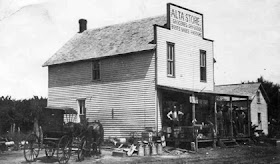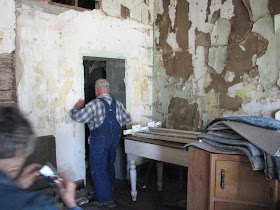DERMOT - Some folks, Charlie Milburn said with a chuckle, call him the mayor of Dermot.
Not that there is much to manage on this section of the hardscrabble
High Plains. The town of Dermot hasn't been around for years.
There's nothing left, he said, except for a cemetery and a one-room
brick school, which has the dubious honor of being the state's last
one-room school, having closed in 1990.
Residents, however, are not about to let what is left of their neighborhood die.
About once a month, Milburn and others gather at the brick school. There they socialize with a potluck supper.
Kansas has more than 6,000 dead towns. Here are a few of them I traveled to as a Hutchinson News journalist.
Sunday, December 18, 2011
Friday, December 16, 2011
Alta Mills, a former Harvey County community.
|
Television radar maps sometimes show the spot along the Little Arkansas River and older folks around these parts still give directions from it. However, what is left of Alta, or Alta Mills as it was commonly called, is hidden by the overgrowth - a foundation, an old warehouse, a dilapidated home. |
| Brian Stucky at the site of Alta Mills. In the background is the home is grandfather, John, lived in and raised Brian's father, Ransom. |
| The old mill, nothing but a foundation. |
| You can see the remains of the dam. |
| Stucky at the site of the mill. |
| The mill warehouse. |
 |
| Stucky and Terry Critchfield talk at the mill site. |
 |
| An old photograph of the Alta Mills store. |
| The John Stucky home. |
 |
| The Mill. At the turn of the 20th Century. |
Zenith, a dead town in Stafford County
 |
| Zenith flourished once, long years ago, but withered badly with the march of years. Now comes again new vigor and new life, springing from the petroleum inoculation. Stafford Courier, March 17, 1938 |
 | ||||
| Here's a photo from Zenith's heydays - notice all the oil wells! |
ZENITH - Earl Hayes recalls a day when oil wells filled the horizon here. Back then, in the 1930s and 1940s, his little hometown of Zenith in Stafford County was spurting with the industry. The Stanolinds and Sinclairs even did business in town. There was a school, lumberyards and groceries. People moved to town and built homes. "They drew 20 million barrels of oil out of that field," the 96-year-old retired farmer said. More than 75 years have passed since Zenith's glory days, said Hayes, who now lives in Hutchinson. Trees voluntarily grow in masses across vacant lots, in between a sundry of old cars in the once bustling town just off Highway 50. Moreover, the elementary school has been empty of students for almost 50 years.
 |
| The old Zenith school. |
 | ||||
| The Zenith elevator still operates |
Zenith was a cast-off. The name, which means "highest point attained," once was Sylvia, according to a story in the Stafford Courier from 1938. A man named Tom Anderson had a store there in 1874. There also was a post office called Zenith. "With the coming of the railroad, the name of Zenith was cast aside in favor of Sylvia," according to the paper. According to an account by Frances McComb Brownlee, who wrote a historical column for the Courier, the Zenith post office was moved to the town's present location around the year 1886. The town began to grow. There was a general store, blacksmith shop, cream station and lumberyard. The Farmers' Elevator was organized in 1905. A Sunday school was held in the lumberyard until a Presbyterian church was built in 1911. The bank and school district were organized in 1914. And, in 1914, Bert McComb and Bill Johnson, owners of the store, partnered together to sell Studebakers and Buicks. But, as with many a prairie town, life began to decline. The bank was sold in 1929. The auto dealership moved to Stafford. A high school closed in 1926, with high school students shipped to Stafford to receive an education. Then, one morning in 1937, "the cry of abundant oil hit the headlines of the daily papers," Brownlee wrote. The first well was discovered a half mile south of Zenith. It produced 800 barrels a day with great gas pressure. "Leasing was at a wild pace," Brownlee wrote. According to a 1938 story in the Stafford Courier, Zenith became one of the state's major oilfields.
Friday, November 18, 2011
Selkirk, Kansas, WIchita County
AP story from Dec. 26, 1956
A freight car loaded with a secret shipment of government exploseives caught fire and blew up at the edge of Selkirk last night. The blas broke out a least half the window panes in town. Amost every building shoed some damage. A 300-ound cunk fo steel hurtled a quarter of a mile into Main street and clipped power lines. But no one was hurt.
Selkirk is a town of few than 100 in western Kansas, about 30 miles from the Colorado line. The boxcar was in a fast westbound freight on the Missouri Pacific and railroaders said a hot box set it afire. An axle bearing ran dry of lubricant, turned red hot and burst into flame.
Crewmen cut off the train behind the burign car nad pulled into a siding. They also uncoupled about six cars ahead of the explosives and pulled ahead. Debris from the explosion blocked the mainline only a short time.
A Missouri Pacific spokesman in Kansas City said he didn’t know what kind of explosives was in the car “and I couldn’t tell you if I knew because it was a secret government shipment.”
Monday, June 27, 2011
Trousdale, Kansas -
The Greensburg tornado did hit it in 2007.
NFL coach NFL's Bruce DeHaven admits he was wary of the new structure. He didn't know if he wanted to see the new church in place of the one he attended every Sunday when he was growing up. However, when Ron and Arnita Schultz, his cousins, celebrated their 50th wedding anniversary a few years ago, he couldn't miss it. "They really did a nice job," he said "And they were able to put some of the features of the other church in it." DeHaven said he learned a lot while growing up in his hometown. He played football, basketball and ran track in high school. His 8-man football team was good, he noted. The team was 8-1 his junior year and went undefeated for Belpre's last season in 1965. DeHaven has coached 25 years in the NFL, including 13 seasons with the Bills. He's made four Super Bowl appearances in a row with the Bills, but has no championships. Coincidentally, he said, he isn't the only NFL coach to live near Trousdale. Ollie Spencer, who was the offensive line coach for the Oakland Raiders under John Madden, lived not far from the DeHaven farm. Spencer also played professional football, as well. DeHaven said he tries to get back to his hometown every year. He and his sister own the land his parents' farmed. Ron Schultz farms it now. It is sad to see small Kansas towns like Trousdale whither away, DeHaven said. "But I sure have fond memories of the place and the people who lived there," he said. "It was just a family oriented community and such an ideal place to be raised. "It was one of those places that it wasn't just your parents but the whole community who raised you," he said. "Kids today would be so lucky to have so many role models in their life."
Tuesday, May 24, 2011
Hopewell, Kansas, a Pratt County Ghost Town
| Hopewell started in 1904 as a post office. The post office closed in 1908.
The post office again opened by 1916, with the town taking the name of Fravel. The Fravel post office changed to Hopewell in 1921.
The town soon began to grow, springing up with the railroad. Ninety-one-year-old Geraldine McAhren, of Byers, who grew up in Hopewell and is Giles' aunt, said the Farmer's State Bank of Hopewell
opened for business about the same time as the name change. The town also had a general store, a hotel, elevators, a blacksmith, a hardware store and lumberyard. The bank housed the post office until it closed in the mid-1920s, she said. Fun included going to school and church, McAhren said. A local couple, Roy and Mina Hodson, befriended her. She would sit on their laps at church and, when she was older, was in a quartet with Roy. Other activities included rabbit hunts, wrote Kansas ghost town author Daniel Fitzgerald. For instance, Hopewell's two lodges had a wager for an oyster dinner to see who could get the most rabbits. The winning team corralled more than 700 rabbits and herded them to a buyer at Byers. The buyer paid 75 cents each for jackrabbits and 35 cents apiece for cottontails. Yet, while there were signs of prospering in the beginning, little Hopewell never took off.  |
| Hopewell Cemetery |
 |
| Sheep populate Hopewell these days. |
 |
| A structure in the trees |
Monday, May 9, 2011
Buda, Kansas - Ness County
 |
| Buda Cemetery - now a gathering place on Memorial Day |
 |
| Marker shows thelocation of Buda school. |
 |
| Buda's first school |
 |
| Buda's second school. |
 |
| A windmill at the cemetery |
BUDA - There was not much in this little spot when Earl McVicker's ancestors first homesteaded here, a family with three children at the time, all living in a small dugout on a parcel of untouched prairie.
Buda, however, didn't have to be big to be a gathering place for area farmers and others - a place where residents met for potlucks and songs. The town of sorts did once have a hotel, a grocery and a post office in the 1800s, and of course, founders had dreams of it getting bigger.
Aulne, Kansas - Marion County
| ||
121811.jpg)





122511.jpg)

122511.jpg)











